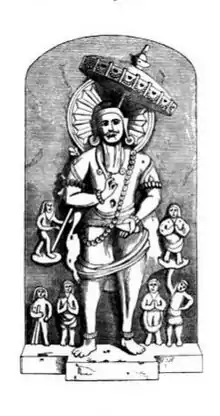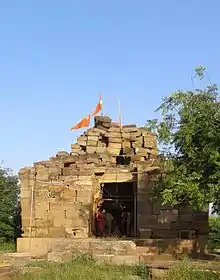Vanaraja Chavda
Vanaraja (IAST:Vanarāja Cāvaḍā) was the most prominent king of the Chavda dynasty who ruled Gujarat from c. 746 CE to c. 780 CE.[1][2]
| Vanaraja Chavda | |
|---|---|
 Vanraj Chavda, a woodcut by Alexander Kinloch Forbes in Râs Mâlâ (1856) based on a statue at Sidhpur. | |
| King of Anahilawada | |
| Reign | c. 746 – c. 780 CE |
| Successor | Yogaraja |
| Dynasty | Chavda dynasty |
| Father | Jayaśekhara |
| Mother | Rupasundari |
Life
Early life
Kṛishṇabhaṭṭa’s Ratnamálá (c. 1230 CE) says that in 696 CE (Samvat 752) Jayaśekhara, the Chavda king of Pañchásar, a village (in modern-day Patan district, Gujarat), was attacked by the Chaulukya king Bhuvaḍa of Kalyánakaṭaka in Kanyákubja (probably Kanauj) and slain by Bhuvaḍa in battle. Before his death Jayaśekhara, he sent his pregnant wife Rupasundarí to the forest in charge of her brother Surapála, one of his chief warriors. After Jayaśekhara’s death, Rupasundarí gave birth to a son named Vanarája.[3][4]
Merutuṇga, the author of the Prabandhachintámaṇi, tells a story that Rupasundarí was living in the forest swinging her son in a hammock, when a Jain monk named Śílaguṇasúri noticing as he passed royal marks on the boy bought him from his mother. The story adds that a nun named Víramatí brought up the boy whom the monks called Vanarája, literally "the forest king". When eight years old, the monk told Vanarája to protect his place of worship from rats. The boy’s skill in shooting rats convinced the monk he was not fit to be a monk but was worthy of a kingdom. He therefore returned the boy to his mother. These details seem invented by the Jain writers themselves. No mention of any such story occurs in the Ratnamálá.[upper-alpha 1][3][4]
In the forests where Vanarája passed his youth lived his maternal uncle Surapála, one of Jayaśekhara’s generals, who, after his sovereign’s defeat and death, had become an outlaw. Vanarája grew up under Surapála’s charge. The Prabandhachintámaṇi records the following story of the origin of Vanarája’s wealth. A Kanyákubja king married Maháṇaká, the daughter of a Gujarát king. To receive the proceeds of the marriage cess which the Gujarát king had levied from his subjects, a deputation or panchkúla came from Kanyákubja to Gujarát. The deputation made Vanarája their leader or sellabhrit to realize the proceeds of the cess. In six months Vanarája collected 24 lákhs of Páruttha drammas[upper-alpha 2] and 4000 horse, which the deputation took and started for Kanyákubja. Vanarája waylaid and killed them, secured the money and horses, and remained in hiding for a year. With the wealth thus acquired Vanarája enrolled an army and established his power assuming the title of king.[3]
Accession to Aṇahilaváḍa
Aṇahilaváḍa (or Aṇahilapura, now Patan, Gujarat) was founded in 746 or 765 CE. The story of the choice of the site is the usual story of a hunted hare turning on the hounds showing the place to be the special nurse of strength and courage. Vanarája is said to have asked a Bharváḍ or Shepherd named Aṇahila son of Śákhadá to show him the best site. Aṇahila agreed on condition that the city should be called by his name. Aṇahila accordingly showed Vanarája the place where a hare had attacked and chased a dog. The city may have been called after some local chief since it was popularly known as Aṇahilaváḍa (Sanskrit:Aṇahilaváta) that is "the place of Aṇahila".[3]
In the Prabandhachintámaṇi, Merutuṇga gives 746 CE (S. 802) as the date of the accession of Vanarája, while in his Vicháraśreṇi the same author gives 765 CE (S. 821 Vaisakha Śukla 2) as the date of the foundation of the city. The discrepancy may be explained by taking 746 CE (S. 802) to refer to the date of Vanarája’s getting money enough to fix the site of his capital, and 765 CE (S. 821) to refer to the date of his accession in the completed Aṇahilaváḍa. According to local tradition, an image of Ganpati in the city also have an inscription dated S. 802 but it seems late installation.[3][4]
Vicháraśreṇi gives 765 (S. 821) seems the more probable date for the accession to the throne as the Prabandhachintámaṇi says that Vanarája accessed to throne at Aṇahilapura when he was about fifty.[upper-alpha 3] This accords with the date fixed on other grounds. Placing Vanarája’s birth at about 720 CE would make him 44 in 765 CE (S. 821) corresponding to date mentioned in the Vicháraśreṇi. Merutuṇga in both his works gives the length of Vanarája’s life at 109 and of his reign at sixty years. The figure 60 seems to mark the length of his life and not of his reign. So long a reign as sixty years is barely possible for a sovereign who succeeded late in life, and the 109 years of his life can hardly be correct. Taking Vanarája’s age at 45 when he was installed in 765 CE (S. 821) and allowing fifteen years more to complete the sixty years, he probably died circa 780 (S. 836), the closing year of his reign. Vanraja was succeeded by his son, Yogaraja.[3]
The Prabandhachintámaṇi narrates how generously Vanarája rewarded those who had helped him in his adversity. His installation was performed by a woman named Śrí Deví of Kákara village (probably Kankrej) whom in fulfillment of an early promise Vanarája had taken to be his sister. The story regarding the promise is that once when Vanarája had gone with his uncle on a thieving expedition to Kákara village and had broken into the house of a merchant he by mistake dipped his hand into a pot of curds. As to touch curds is the same as to dine at a house as a guest, Vanarája left the house without taking anything from it. Hearing what had happened the merchant’s sister invited Vanarája as a brother to dinner and gave him clothes. In return Vanarája promised if he ever regained his father’s kingdom he should receive his installation as king at her hands. Vanarája chose as minister a Baniya named Jámba. The story is that while Vanarája was looting with two others he came across a merchant Jámba who had five arrows. Seeing only three enemies, Jámba broke and threw away two of the arrows, shouting ‘One for each of you.’ Vanarája admiring his coolness persuaded Jámba to join his band and found him so useful that he promised to make him minister. From the absence of any reference to him in these and similar tales it is probable that his uncle Surapála died before the installing of Vanarája.[3]
The Kuvalayamālā mentions a legend about Vanaraja that he was assisted by a Jain monk in acquiring his kingdom.[5]
He also credited with the foundation of Champaner, in honour one of his generals, Champa.
Image
Vanarája is said to have built at Aṇahilváḍa a Jain temple of Pañchásará Parshwanath so called because the image was brought from the old settlement of Pañchásar. Mention of this temple continues during the Chaulukya and Vághelá times. Vanarája is said to have placed a bowing image of himself facing the image of Parshwanatha.[3]
The figure of Vanarája is still shown at Sidhpur and a woodcut of it is given by Alexander Kinloch Forbes in his Rás Málá (1856). It is clearly the figure of a king with the umbrella of state and a nimbus round the head and in the ears the long ornaments called kundalas noticed by Arab travellers as characteristic of the Balhara or Ráshṭrakúṭa kings who were contemporary with Vanarája. The king wears a long beard, a short waist-cloth or dhoti, a waistband or kammarband, and a shoulder garment or uparna whose ends hang down the back. Besides the earrings he is adorned with bracelets armlets and anklets and a large ornament hangs across the chest from the left shoulder to the right hip. The right hand is held near the chest in the act of granting protection; and the left hand holds something which cannot be made out. By his side is the umbrella-bearer and five other attendants. The statue closely resembles the lifesize figure of a king of the Chaulukya period lying in the yard of a temple at Maliya about twenty-four miles north of Somnath. At Somnath are similar but less rich contemporary figures of local officers of the Chaulukyas. Another similar figure of which only the torso remains is the statue of Anrája the father of Vastupala in a niche in Vastupála’s temple at Girnár. The details of this figure belong to the Chaulukya period.[3]
Religion

Vanaraja Chavda is not portrayed as a Jain by birth, yet he is shown participating in distinctly Jain rituals of kingship by Jain authors.[6]
Temples
The Merutunga's prabandhachintamani states about Vanrajavihara temple at Anahilapathaka (now Patan, Gujarat) as well as the construction of Kanteshwari-prasada by Vanraja. Vanraja also built Panchasara Parshwanath temple in Patan with main idol of Parshvanatha brought from Panchasar village.[7] Kanteshwari was the petron goddess of later Chaulukya kings too. Kumarapala has prohibited the animal sacrifice at this temple. According to Haribhadra Suri (middle of 12th century), Minister Nihhaya's son Lahara had built the temple of Vindhyavasini (Laharadhanuhavi) at Sander in Patan district. He had also founded Narangpura town and built a Parshwanatha temple for merit of his mother.[8]
The extant temples this period (Early Nagara Phase) include the Roda Group of Temples, Lakodra in Vijapur Taluka, old temple at Thangadh, Ranakdevi Temple at Wadhwan, the Sun Temple at Kanthkot, Shiva temple at Puaranogadh at Manjal in Kutch.[8]
In popular culture
Vanraj Chavdo (1881), a Gujarati novel written by Mahipatram Rupram Nilkanth, is based on the life of Vanraja Chavda.[9]
Notes and references
Notes
- In the Satyapurakalpa of his Tírthákalpa, Jinaprabhasúri tells an almost identical story of another king.
- This name often recurs in Jain works. These would seem to be Kshatrapa coins as Gadhaiya coins are simply called drammas.
- The text is “Pañcháśatavarshadesyaḥ.”
References
- Chintaman Vinayak Vaidya (1979). History of mediaeval Hindu India, Volume 1. Cosmo Publications. p. 355.
- Cort 2001, p. 37.
- James Macnabb Campbell, ed. (1896). "I. THE CHÁVAḌÁS (A. D. 720–956.)". History of Gujarát. Gazetteer of the Bombay Presidency. Volume I. Part I. The Government Central Press. pp. 149–156.
 This article incorporates text from this source, which is in the public domain.
This article incorporates text from this source, which is in the public domain. - Cort 2001, p. 35.
- Sheikh, Samira (2009). The Regions of Gujarat, c. 100–1200. Oxford University Press. p. 54. doi:10.1093/acprof:oso/9780198060192.003.0002. ISBN 9780198060192.
- Cort 1998, p. 87.
- Cort 2010, p. 64.
- Dhaky, Madhusudan A. (1961). Deva, Krishna (ed.). "The Chronology of the Solanki Temples of Gujarat". Journal of the Madhya Pradesh Itihas Parishad. Bhopal: Madhya Pradesh Itihas Parishad. 3: 3–6, 10–12, 70.
- Jani, Darsha (2013). "Chapter 2". A comparative study of the major historical novels of Sir Walter Scott and Shri Kanaiyalal Munshi (PhD). p. 58.
Bibliography
- Cort, John E., ed. (1998), Open Boundaries: Jain Communities and Cultures in Indian History, SUNY Press, ISBN 0-7914-3785-X
- Cort, John E. (2001), Jains in the World : Religious Values and Ideology in India, Oxford University Press, ISBN 0-19-513234-3
- Cort, John E. (2010), Framing the Jina: Narratives of Icons and Idols in Jain History, Oxford University Press, ISBN 9780195385021